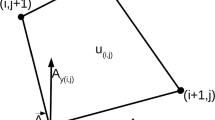Abstract
The strategies that minimize the overall solution time of multiple linear systems in 3D finite element method (FEM) modeling of direct current (DC) resistivity were discussed. A global stiff matrix is assembled and stored in two parts separately. One part is associated with the volume integral and the other is associated with the subsurface boundary integral. The equivalent multiple linear systems with closer right-hand sides than the original systems were constructed. A recycling Krylov subspace technique was employed to solve the multiple linear systems. The solution of the seed system was used as an initial guess for the subsequent systems. The results of two numerical experiments show that the improved algorithm reduces the iterations and CPU time by almost 50%, compared with the classical preconditioned conjugate gradient method.
Similar content being viewed by others
References
DEY A, MORRISON H F. Resistivity modeling for arbitrarily shaped three-dimensional structures [J]. Geophysics, 1979, 44(4): 753–780.
LI Y, SPITZER K. Three-dimensional DC resistivity forward modeling using finite elements in comparison with finite-difference solutions [J]. Geophys J Int, 2002, 151(3): 924–934.
RUAN B Y, XIONG B, XU S Z. Finite element method for modeling resistivity sounding 3-D geo-electric section [J]. Earth Science-Journal of China University of Geosciences, 2001, 26(1): 73–77.
TANG J T, REN Z R, HUA X R. Triangle and tetrahedral finite element meshing from arbitrary geophysical model data [J]. Progress in Geophysics, 2006, 21(4): 1272–1280. (in Chinese)
WU X P, WANG T T. A 3D finite element resistivity forward modeling using conjugate gradient algorithm [J]. Chinese Journal of Geophysics, 2003, 46(3): 428–432. (in Chinese)
XU S Z. The finite element method in geophysics [M]. Beijing: Science Press, 1994: 173–183. (in Chinese)
RÜCKER C, GÜNTHER T, SPITZER K. Three-dimensional modeling and inversion of dc resistivity data incorporating topography: I. Modeling [J]. Geophys J Int, 2006, 166(2): 495–505.
BLOME M, MAURER H R, SCHMIDT K. Advances in three-dimensional geoelectric forward solver techniques [J]. Geophys J Int, 2009, 176(3): 740–752.
SAAD Y. Iterative methods for sparse linear systems [M]. 2nd Edition. Society for Industrial and Applied Mathematics, 2003.
ÓLEARY D P. The block conjugate gradient algorithm and related methods [J]. Linear Algebra Appl, 1980, 29: 293–322.
FREUND R W, MALHOTRA M. A block QMR algorithm for non-Hermitian linear systems with multiple right-hand sides [J]. Linear Algebra Appl, 1997, 254(1): 119–157.
MORGAN R B. Restarted block-GMRES with deflation of eigenvalues [J]. Appl Numer Math, 2005, 54(2): 222–236.
PARKS M L, de STURLER E, MACKEY G, et al. Recycling Krylov subspaces for sequences of linear systems [J]. SIAM Journal on Scientific Computing, 2006, 28(5): 1651–1674.
GIRAUD L, RUIZ D, TOUHAMI A. A comparative study of iterative solvers exploiting spectral information for SPD systems [J]. SIAM Journal on Scientific Computing, 2006, 27(5): 1760–1786.
SALKUYEH D K. CG-type algorithms to solve symmetric matrix equations [J]. Applied Mathematics and Computation, 2006, 172(2): 985–999.
GOLUB G H, RUIZ D, TOUHAMI A. A hybrid approach combining Chebyshev filter and conjugate gradient for solving linear systems with multiple right-hand sides [J]. SIAM J Matrix Anal Appl, 2007, 29(3): 774–795.
CHAN T F, NG M K. Galerkin projection methods solving multiple linear systems [J]. SIAM Journal on Scientific Computing, 1999, 21(3): 836–850.
ERHEL J, GUYOMARĆH F. An augmented conjugate gradient method for solving consecutive symmetric positive definite linear systems [J]. SIAM J Matrix Anal Appl, 2000, 21(4): 1279–1299.
WANG S, DE STURLER E, PAULINO G H. Large-scale topology optimization using preconditioned Krylov subspace methods with recycling [J]. Int J Numer Meth Engng, 2007, 69(12): 2441–2468.
JIN C, CAI X C. A preconditioned recycling GMRES solver for Stochastic Helmholtz problems [J]. Commun Comput Phys, 2009, 6(2): 342–353.
CLEMENS M, HELIAS M, STEINMETZ T, WIMMER G. Multiple right-hand side techniques for the numerical simulation of quasistatic electric and magnetic fields [J]. Journal of Computational and Applied Mathematics, 2008, 215(2): 328–338.
MELLO L A M, de STURLER E, PAULINO G H, SILVA E C. Recycling Krylov subspaces for efficient large-scale electrical impedance tomography [J]. Comput Methods Appl Mech Engrg, 2010, 199(49): 3101–3110.
KILMER M E, de STURLER E. Recycling subspace information for diffuse optical tomography [J]. SIAM Journal on Scientific Computing, 2006, 27(6): 2140–2166.
Author information
Authors and Affiliations
Corresponding author
Additional information
Foundation item: Projects(40974077, 41164004) supported by the National Natural Science Foundation of China; Project(2007AA06Z134) supported by the National High Technology Research and Development Program of China; Projects(2011GXNSFA018003, 0832263) supported by the Natural Science Foundation of Guangxi Province, China; Project supported by Program for Excellent Talents in Guangxi Higher Education Institution, China; Project supported by the Foundation of Guilin University of Technology, China
Rights and permissions
About this article
Cite this article
Li, Cw., Xiong, B., Qiang, Jk. et al. Multiple linear system techniques for 3D finite element method modeling of direct current resistivity. J. Cent. South Univ. Technol. 19, 424–432 (2012). https://doi.org/10.1007/s11771-012-1021-6
Received:
Accepted:
Published:
Issue Date:
DOI: https://doi.org/10.1007/s11771-012-1021-6




